
Illustrative Math Alignment: Grade 7 Unit 8
Probability and Sampling
Lesson 1: Mystery Bags
Use the following Media4Math resources with this Illustrative Math lesson.
| Thumbnail Image | Title | Body | Curriculum Topic |
|---|---|---|---|
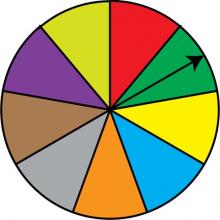
|
Math Clip Art: Spinner, 9 Sections--Result 2 | Math Clip Art: Spinner, 9 Sections--Result 2TopicProbability and Statistics DescriptionThis image showcases a spinner divided into nine equal sections colored red, green, dark yellow, light blue, orange, grey, brown, purple, and light yellow. The spinner's arrow points to the green section, illustrating another possible outcome. In Probability and Statistics, this spinner represents a fair probability experiment with nine mutually exclusive and equally likely outcomes. It provides a visual representation of how each spin has an equal 1/9 chance of landing on any of the nine colors. |
Probability |

|
Math Clip Art: Spinner, 9 Sections--Result 2 | Math Clip Art: Spinner, 9 Sections--Result 2TopicProbability and Statistics DescriptionThis image showcases a spinner divided into nine equal sections colored red, green, dark yellow, light blue, orange, grey, brown, purple, and light yellow. The spinner's arrow points to the green section, illustrating another possible outcome. In Probability and Statistics, this spinner represents a fair probability experiment with nine mutually exclusive and equally likely outcomes. It provides a visual representation of how each spin has an equal 1/9 chance of landing on any of the nine colors. |
Probability |

|
Math Clip Art: Spinner, 9 Sections--Result 2 | Math Clip Art: Spinner, 9 Sections--Result 2TopicProbability and Statistics DescriptionThis image showcases a spinner divided into nine equal sections colored red, green, dark yellow, light blue, orange, grey, brown, purple, and light yellow. The spinner's arrow points to the green section, illustrating another possible outcome. In Probability and Statistics, this spinner represents a fair probability experiment with nine mutually exclusive and equally likely outcomes. It provides a visual representation of how each spin has an equal 1/9 chance of landing on any of the nine colors. |
Probability |

|
Math Clip Art: Spinner, 9 Sections--Result 3 | Math Clip Art: Spinner, 9 Sections--Result 3TopicProbability and Statistics DescriptionThis image displays a spinner divided into nine equal sections colored red, green, dark yellow, light blue, orange, grey, brown, purple, and light yellow. The spinner's arrow points to the dark yellow section, showcasing another possible outcome in this probability model. In the field of Probability and Statistics, this spinner exemplifies a uniform probability distribution with nine equally likely outcomes. Each spin has a 1/9 probability of landing on any given color, illustrating the concept of equiprobable events in a more complex scenario. |
Probability |

|
Math Clip Art: Spinner, 9 Sections--Result 3 | Math Clip Art: Spinner, 9 Sections--Result 3TopicProbability and Statistics DescriptionThis image displays a spinner divided into nine equal sections colored red, green, dark yellow, light blue, orange, grey, brown, purple, and light yellow. The spinner's arrow points to the dark yellow section, showcasing another possible outcome in this probability model. In the field of Probability and Statistics, this spinner exemplifies a uniform probability distribution with nine equally likely outcomes. Each spin has a 1/9 probability of landing on any given color, illustrating the concept of equiprobable events in a more complex scenario. |
Probability |

|
Math Clip Art: Spinner, 9 Sections--Result 3 | Math Clip Art: Spinner, 9 Sections--Result 3TopicProbability and Statistics DescriptionThis image displays a spinner divided into nine equal sections colored red, green, dark yellow, light blue, orange, grey, brown, purple, and light yellow. The spinner's arrow points to the dark yellow section, showcasing another possible outcome in this probability model. In the field of Probability and Statistics, this spinner exemplifies a uniform probability distribution with nine equally likely outcomes. Each spin has a 1/9 probability of landing on any given color, illustrating the concept of equiprobable events in a more complex scenario. |
Probability |
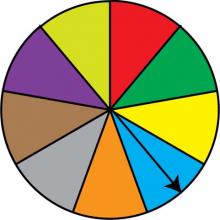
|
Math Clip Art: Spinner, 9 Sections--Result 4 | Math Clip Art: Spinner, 9 Sections--Result 4TopicProbability and Statistics DescriptionThis image presents a spinner divided into nine equal sections colored red, green, dark yellow, light blue, orange, grey, brown, purple, and light yellow. The spinner's arrow points to the light blue section, demonstrating another possible outcome in this probability model. In Probability and Statistics, this spinner illustrates a fair probability experiment with nine mutually exclusive and equally likely outcomes. It provides a visual representation of how each spin has an equal 1/9 chance of landing on any of the nine colors. |
Probability |

|
Math Clip Art: Spinner, 9 Sections--Result 4 | Math Clip Art: Spinner, 9 Sections--Result 4TopicProbability and Statistics DescriptionThis image presents a spinner divided into nine equal sections colored red, green, dark yellow, light blue, orange, grey, brown, purple, and light yellow. The spinner's arrow points to the light blue section, demonstrating another possible outcome in this probability model. In Probability and Statistics, this spinner illustrates a fair probability experiment with nine mutually exclusive and equally likely outcomes. It provides a visual representation of how each spin has an equal 1/9 chance of landing on any of the nine colors. |
Probability |

|
Math Clip Art: Spinner, 9 Sections--Result 4 | Math Clip Art: Spinner, 9 Sections--Result 4TopicProbability and Statistics DescriptionThis image presents a spinner divided into nine equal sections colored red, green, dark yellow, light blue, orange, grey, brown, purple, and light yellow. The spinner's arrow points to the light blue section, demonstrating another possible outcome in this probability model. In Probability and Statistics, this spinner illustrates a fair probability experiment with nine mutually exclusive and equally likely outcomes. It provides a visual representation of how each spin has an equal 1/9 chance of landing on any of the nine colors. |
Probability |
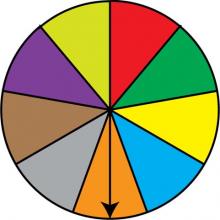
|
Math Clip Art: Spinner, 9 Sections--Result 5 | Math Clip Art: Spinner, 9 Sections--Result 5TopicProbability and Statistics DescriptionThis image showcases a spinner divided into nine equal sections colored red, green, dark yellow, light blue, orange, grey, brown, purple, and light yellow. The spinner's arrow points to the orange section, illustrating another possible outcome in this probability model. In the context of Probability and Statistics, this spinner represents a probability experiment with nine equally likely outcomes. It visually demonstrates the concepts of sample space and individual events within that space, each with a 1/9 probability of occurrence. |
Probability |

|
Math Clip Art: Spinner, 9 Sections--Result 5 | Math Clip Art: Spinner, 9 Sections--Result 5TopicProbability and Statistics DescriptionThis image showcases a spinner divided into nine equal sections colored red, green, dark yellow, light blue, orange, grey, brown, purple, and light yellow. The spinner's arrow points to the orange section, illustrating another possible outcome in this probability model. In the context of Probability and Statistics, this spinner represents a probability experiment with nine equally likely outcomes. It visually demonstrates the concepts of sample space and individual events within that space, each with a 1/9 probability of occurrence. |
Probability |

|
Math Clip Art: Spinner, 9 Sections--Result 5 | Math Clip Art: Spinner, 9 Sections--Result 5TopicProbability and Statistics DescriptionThis image showcases a spinner divided into nine equal sections colored red, green, dark yellow, light blue, orange, grey, brown, purple, and light yellow. The spinner's arrow points to the orange section, illustrating another possible outcome in this probability model. In the context of Probability and Statistics, this spinner represents a probability experiment with nine equally likely outcomes. It visually demonstrates the concepts of sample space and individual events within that space, each with a 1/9 probability of occurrence. |
Probability |
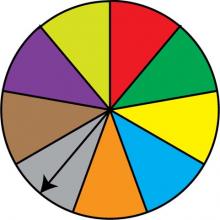
|
Math Clip Art: Spinner, 9 Sections--Result 6 | Math Clip Art: Spinner, 9 Sections--Result 6TopicProbability and Statistics DescriptionThis image displays a spinner divided into nine equal sections colored red, green, dark yellow, light blue, orange, grey, brown, purple, and light yellow. The spinner's arrow points to the grey section, showcasing another possible outcome in this probability model. In the field of Probability and Statistics, this spinner exemplifies a uniform probability distribution with nine equally likely outcomes. Each spin has a 1/9 probability of landing on any given color, illustrating the concept of equiprobable events in a more complex scenario. |
Probability |

|
Math Clip Art: Spinner, 9 Sections--Result 6 | Math Clip Art: Spinner, 9 Sections--Result 6TopicProbability and Statistics DescriptionThis image displays a spinner divided into nine equal sections colored red, green, dark yellow, light blue, orange, grey, brown, purple, and light yellow. The spinner's arrow points to the grey section, showcasing another possible outcome in this probability model. In the field of Probability and Statistics, this spinner exemplifies a uniform probability distribution with nine equally likely outcomes. Each spin has a 1/9 probability of landing on any given color, illustrating the concept of equiprobable events in a more complex scenario. |
Probability |

|
Math Clip Art: Spinner, 9 Sections--Result 6 | Math Clip Art: Spinner, 9 Sections--Result 6TopicProbability and Statistics DescriptionThis image displays a spinner divided into nine equal sections colored red, green, dark yellow, light blue, orange, grey, brown, purple, and light yellow. The spinner's arrow points to the grey section, showcasing another possible outcome in this probability model. In the field of Probability and Statistics, this spinner exemplifies a uniform probability distribution with nine equally likely outcomes. Each spin has a 1/9 probability of landing on any given color, illustrating the concept of equiprobable events in a more complex scenario. |
Probability |
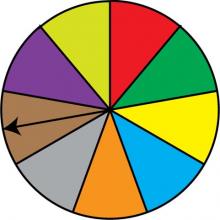
|
Math Clip Art: Spinner, 9 Sections--Result 7 | Math Clip Art: Spinner, 9 Sections--Result 7TopicProbability and Statistics DescriptionThis image presents a spinner divided into nine equal sections colored red, green, dark yellow, light blue, orange, grey, brown, purple, and light yellow. The spinner's arrow points to the brown section, demonstrating another possible outcome in this probability model. In Probability and Statistics, this spinner illustrates a fair probability experiment with nine mutually exclusive and equally likely outcomes. It provides a visual representation of how each spin has an equal 1/9 chance of landing on any of the nine colors. |
Probability |

|
Math Clip Art: Spinner, 9 Sections--Result 7 | Math Clip Art: Spinner, 9 Sections--Result 7TopicProbability and Statistics DescriptionThis image presents a spinner divided into nine equal sections colored red, green, dark yellow, light blue, orange, grey, brown, purple, and light yellow. The spinner's arrow points to the brown section, demonstrating another possible outcome in this probability model. In Probability and Statistics, this spinner illustrates a fair probability experiment with nine mutually exclusive and equally likely outcomes. It provides a visual representation of how each spin has an equal 1/9 chance of landing on any of the nine colors. |
Probability |

|
Math Clip Art: Spinner, 9 Sections--Result 7 | Math Clip Art: Spinner, 9 Sections--Result 7TopicProbability and Statistics DescriptionThis image presents a spinner divided into nine equal sections colored red, green, dark yellow, light blue, orange, grey, brown, purple, and light yellow. The spinner's arrow points to the brown section, demonstrating another possible outcome in this probability model. In Probability and Statistics, this spinner illustrates a fair probability experiment with nine mutually exclusive and equally likely outcomes. It provides a visual representation of how each spin has an equal 1/9 chance of landing on any of the nine colors. |
Probability |

|
Math Clip Art: Spinner, 9 Sections--Result 8 | Math Clip Art: Spinner, 9 Sections--Result 8TopicProbability and Statistics DescriptionThis image showcases a spinner divided into nine equal sections colored red, green, dark yellow, light blue, orange, grey, brown, purple, and light yellow. The spinner's arrow points to the purple section, illustrating another possible outcome in this probability model. In the context of Probability and Statistics, this spinner represents a probability experiment with nine equally likely outcomes. It visually demonstrates the concepts of sample space and individual events within that space, each with a 1/9 probability of occurrence. |
Probability |

|
Math Clip Art: Spinner, 9 Sections--Result 8 | Math Clip Art: Spinner, 9 Sections--Result 8TopicProbability and Statistics DescriptionThis image showcases a spinner divided into nine equal sections colored red, green, dark yellow, light blue, orange, grey, brown, purple, and light yellow. The spinner's arrow points to the purple section, illustrating another possible outcome in this probability model. In the context of Probability and Statistics, this spinner represents a probability experiment with nine equally likely outcomes. It visually demonstrates the concepts of sample space and individual events within that space, each with a 1/9 probability of occurrence. |
Probability |

|
Math Clip Art: Spinner, 9 Sections--Result 8 | Math Clip Art: Spinner, 9 Sections--Result 8TopicProbability and Statistics DescriptionThis image showcases a spinner divided into nine equal sections colored red, green, dark yellow, light blue, orange, grey, brown, purple, and light yellow. The spinner's arrow points to the purple section, illustrating another possible outcome in this probability model. In the context of Probability and Statistics, this spinner represents a probability experiment with nine equally likely outcomes. It visually demonstrates the concepts of sample space and individual events within that space, each with a 1/9 probability of occurrence. |
Probability |
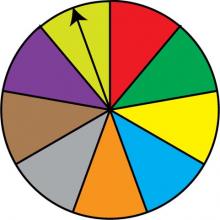
|
Math Clip Art: Spinner, 9 Sections--Result 9 | Math Clip Art: Spinner, 9 Sections--Result 9TopicProbability and Statistics DescriptionThis image displays a spinner divided into nine equal sections colored red, green, dark yellow, light blue, orange, grey, brown, purple, and light yellow. The spinner's arrow points to the light yellow section, showcasing the final possible outcome in this probability model. In the field of Probability and Statistics, this spinner exemplifies a uniform probability distribution with nine equally likely outcomes. Each spin has a 1/9 probability of landing on any given color, illustrating the concept of equiprobable events in a more complex scenario. |
Probability |

|
Math Clip Art: Spinner, 9 Sections--Result 9 | Math Clip Art: Spinner, 9 Sections--Result 9TopicProbability and Statistics DescriptionThis image displays a spinner divided into nine equal sections colored red, green, dark yellow, light blue, orange, grey, brown, purple, and light yellow. The spinner's arrow points to the light yellow section, showcasing the final possible outcome in this probability model. In the field of Probability and Statistics, this spinner exemplifies a uniform probability distribution with nine equally likely outcomes. Each spin has a 1/9 probability of landing on any given color, illustrating the concept of equiprobable events in a more complex scenario. |
Probability |

|
Math Clip Art: Spinner, 9 Sections--Result 9 | Math Clip Art: Spinner, 9 Sections--Result 9TopicProbability and Statistics DescriptionThis image displays a spinner divided into nine equal sections colored red, green, dark yellow, light blue, orange, grey, brown, purple, and light yellow. The spinner's arrow points to the light yellow section, showcasing the final possible outcome in this probability model. In the field of Probability and Statistics, this spinner exemplifies a uniform probability distribution with nine equally likely outcomes. Each spin has a 1/9 probability of landing on any given color, illustrating the concept of equiprobable events in a more complex scenario. |
Probability |
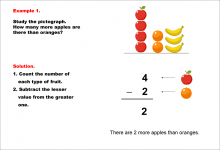
|
Math Example--Charts, Graphs, and Plots--Reading and Interpreting Scaled Graphs--Example 1 | Math Example--Charts, Graphs, and Plots-- Reading and Interpreting Scaled Graphs--Example 1
In this set of math examples, analyze the behavior of different scatterplots. This includes linear and quadratic models. |
Subtraction Facts to 100 and Data Analysis |
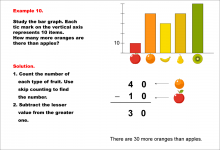
|
Math Example--Charts, Graphs, and Plots--Reading and Interpreting Scaled Graphs--Example 10 | Math Example--Charts, Graphs, and Plots-- Reading and Interpreting Scaled Graphs--Example 10
In this set of math examples, analyze the behavior of different scatterplots. This includes linear and quadratic models. |
Subtraction Facts to 100 and Data Analysis |
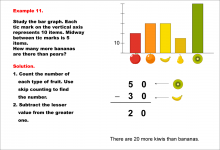
|
Math Example--Charts, Graphs, and Plots--Reading and Interpreting Scaled Graphs--Example 11 | Math Example--Charts, Graphs, and Plots-- Reading and Interpreting Scaled Graphs--Example 11
In this set of math examples, analyze the behavior of different scatterplots. This includes linear and quadratic models. |
Subtraction Facts to 100 and Data Analysis |
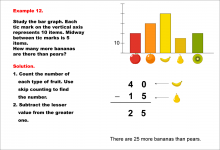
|
Math Example--Charts, Graphs, and Plots--Reading and Interpreting Scaled Graphs--Example 12 | Math Example--Charts, Graphs, and Plots-- Reading and Interpreting Scaled Graphs--Example 12
In this set of math examples, analyze the behavior of different scatterplots. This includes linear and quadratic models. |
Subtraction Facts to 100 and Data Analysis |

|
Math Example--Charts, Graphs, and Plots--Reading and Interpreting Scaled Graphs--Example 13 | Math Example--Charts, Graphs, and Plots-- Reading and Interpreting Scaled Graphs--Example 13
In this set of math examples, analyze the behavior of different scatterplots. This includes linear and quadratic models. |
Subtraction Facts to 100 and Data Analysis |
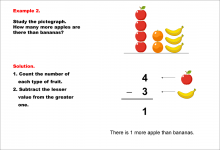
|
Math Example--Charts, Graphs, and Plots--Reading and Interpreting Scaled Graphs--Example 2 | Math Example--Charts, Graphs, and Plots-- Reading and Interpreting Scaled Graphs--Example 2
In this set of math examples, analyze the behavior of different scatterplots. This includes linear and quadratic models. |
Subtraction Facts to 100 and Data Analysis |
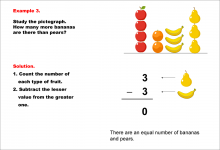
|
Math Example--Charts, Graphs, and Plots--Reading and Interpreting Scaled Graphs--Example 3 | Math Example--Charts, Graphs, and Plots-- Reading and Interpreting Scaled Graphs--Example 3
In this set of math examples, analyze the behavior of different scatterplots. This includes linear and quadratic models. |
Subtraction Facts to 100 and Data Analysis |

|
Math Example--Charts, Graphs, and Plots--Reading and Interpreting Scaled Graphs--Example 4 | Math Example--Charts, Graphs, and Plots-- Reading and Interpreting Scaled Graphs--Example 4
In this set of math examples, analyze the behavior of different scatterplots. This includes linear and quadratic models. |
Subtraction Facts to 100 and Data Analysis |
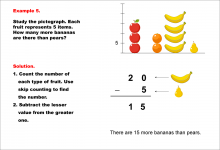
|
Math Example--Charts, Graphs, and Plots--Reading and Interpreting Scaled Graphs--Example 5 | Math Example--Charts, Graphs, and Plots-- Reading and Interpreting Scaled Graphs--Example 5
In this set of math examples, analyze the behavior of different scatterplots. This includes linear and quadratic models. |
Subtraction Facts to 100 and Data Analysis |
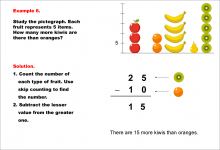
|
Math Example--Charts, Graphs, and Plots--Reading and Interpreting Scaled Graphs--Example 6 | Math Example--Charts, Graphs, and Plots-- Reading and Interpreting Scaled Graphs--Example 6
In this set of math examples, analyze the behavior of different scatterplots. This includes linear and quadratic models. |
Subtraction Facts to 100 and Data Analysis |

|
Math Example--Charts, Graphs, and Plots--Reading and Interpreting Scaled Graphs--Example 7 | Math Example--Charts, Graphs, and Plots-- Reading and Interpreting Scaled Graphs--Example 7
In this set of math examples, analyze the behavior of different scatterplots. This includes linear and quadratic models. |
Subtraction Facts to 100 and Data Analysis |
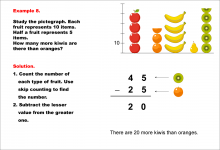
|
Math Example--Charts, Graphs, and Plots--Reading and Interpreting Scaled Graphs--Example 8 | Math Example--Charts, Graphs, and Plots-- Reading and Interpreting Scaled Graphs--Example 8
In this set of math examples, analyze the behavior of different scatterplots. This includes linear and quadratic models. |
Subtraction Facts to 100 and Data Analysis |
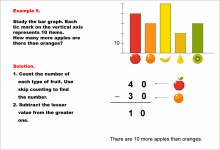
|
Math Example--Charts, Graphs, and Plots--Reading and Interpreting Scaled Graphs--Example 9 | Math Example--Charts, Graphs, and Plots-- Reading and Interpreting Scaled Graphs--Example 9
In this set of math examples, analyze the behavior of different scatterplots. This includes linear and quadratic models. |
Subtraction Facts to 100 and Data Analysis |
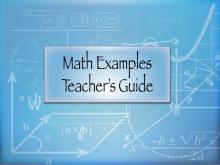
|
MATH EXAMPLES--Teacher's Guide: Probability | MATH EXAMPLES--Teacher's Guide: Probability
This set of tutorials provides 28 examples of how to solve probability problems. This is part of a collection of teacher's guides. To see the complete collection of teacher's guides, click on this link. Note: The download is a PDF file.Related ResourcesTo see resources related to this topic click on the Related Resources tab above. |
Probability |

|
Math in the News: Issue 119--Who Will Win the World Cup? | Math in the News: Issue 119 | Who Will Win the World Cup?
December 2022. In this issue of Math in the News we look at a probability model for predicting the winner of the World Cup. —PRESS PREVIEW TO SEE THE SLIDE SHOW— This is part of the Math in the News collection. To see the complete collection, click on this link.Note: The download is a PPT file. Related ResourcesTo see resources related to this topic click on the Related Resources tab above. |
Probability |

|
Math in the News: Issue 30--An Improbable Collapse! | Math in the News: Issue 30--An Improbable Collapse!
10/10/11. In this issue we look at the Boston Red Sox and their improbable collapse in September. They were one out away from making the playoffs, but they ended their game and season in dramatic fashion. This is part of the Math in the News collection. To see the complete collection, click on this link. Note: The download is a PPT file.Related ResourcesTo see resources related to this topic click on the Related Resources tab above. |
Data Analysis |
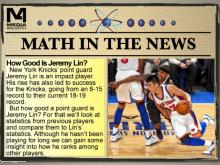
|
Math in the News: Issue 48--How Good Is Jeremy Lin? | Math in the News: Issue 48--How Good Is Jeremy Lin?
February 2012. In this issue of Math in the News, we look at basketball statistics, in particular the stats for Jeremy Lin. This is part of the Math in the News collection. To see the complete collection, click on this link. Note: The download is a PPT file.Related ResourcesTo see resources related to this topic click on the Related Resources tab above. |
Data Analysis |
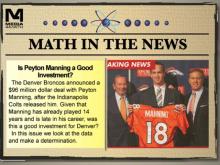
|
Math in the News: Issue 51--Peyton Manning | Math in the News: Issue 51--Is Peyton Manning a Good Investment?
March 2012. In this issue of Math in the News we look at Peyton Manning's new contract with the Denver Broncos. Was this a good deal or not? This is part of the Math in the News collection. To see the complete collection, click on this link. Note: The download is a PPT file.Related ResourcesTo see resources related to this topic click on the Related Resources tab above. |
Data Analysis |
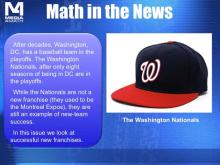
|
Math in the News: Issue 62--The Washington Nationals | Math in the News: Issue 62--The Washington Nationals
September 2012. In this issue of Math in the News we look at the remarkable success of the Washington Nationals baseball team. In the process we look at the success of new baseball franchises and why this happens. This is part of the Math in the News collection. To see the complete collection, click on this link. Note: The download is a PPT file.Related ResourcesTo see resources related to this topic click on the Related Resources tab above. |
Data Analysis |

|
Math in the News: Issue 67--Election Results | Math in the News: Issue 67--Election Results
November 2012. In this issue of Math in the News, we look at statistics for the recent Presidential election. This is part of the Math in the News collection. To see the complete collection, click on this link. Note: The download is a PPT file.Related ResourcesTo see resources related to this topic click on the Related Resources tab above. |
Data Analysis |
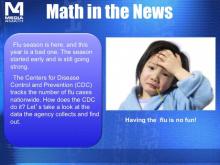
|
Math in the News: Issue 68--Flu Season | Math in the News: Issue 68--Flu Season
February 2013. In this issue of Math in the News, we look at statistics for the flu season. This is part of the Math in the News collection. To see the complete collection, click on this link. Note: The download is a PPT file.Related ResourcesTo see resources related to this topic click on the Related Resources tab above. |
Data Analysis |
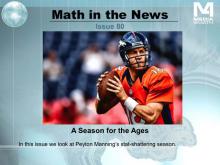
|
Math in the News: Issue 80--A Season for the Ages | Math in the News: Issue 80--A Season for the Ages
October 2013. In this issue we follow Peyton Manning's extraordinary season with the Denver Broncos. This is a follow-up from Issue 51. This is an excellent opportunity to look at different data graphs, including box-and-whisker plots, bar graphs, and tabular data. This is part of the Math in the News collection. To see the complete collection, click on this link. Note: The download is a PPT file.Related ResourcesTo see resources related to this topic click on the Related Resources tab above. |
Data Analysis |
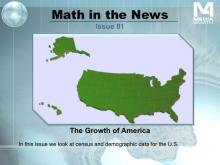
|
Math in the News: Issue 81--The Growth of America | Math in the News: Issue 81--The Growth of America
October 2013. In this issue we look at how America has grown from its formation as a country. We look at the increase in the number of states, the increase in the population, and the demographic factors that have become prominent in recent years. We look at data in tables and graphs. This is part of the Math in the News collection. To see the complete collection, click on this link. Note: The download is a PPT file.Related ResourcesTo see resources related to this topic click on the Related Resources tab above. |
Data Analysis |
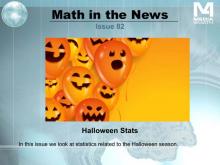
|
Math in the News: Issue 82--Halloween Stats | Math in the News: Issue 82--Halloween Stats
October 2013. In this issue we look at statistics related to Halloween 2013. We explore how the economy is affecting holiday spending. We also investigate why Halloween has grown in popularity over the years. This is part of the Math in the News collection. To see the complete collection, click on this link. Note: The download is a PPT file.Related ResourcesTo see resources related to this topic click on the Related Resources tab above. |
Data Analysis |

|
Math in the News: Issue 82--Halloween Stats | Math in the News: Issue 82--Halloween Stats
October 2013. In this issue we look at statistics related to Halloween 2013. We explore how the economy is affecting holiday spending. We also investigate why Halloween has grown in popularity over the years. This is part of the Math in the News collection. To see the complete collection, click on this link. Note: The download is a PPT file.Related ResourcesTo see resources related to this topic click on the Related Resources tab above. |
Data Analysis |

|
Math in the News: Issue 85--2013 Movies: A Year in Review | Math in the News: Issue 85--2013 Movies: A Year in Review
January 2014. In this issue of Math in the News we look at box office data from 2013. We look for patterns in the data and analyze the data using different data displays, including bar graphs, line graphs, scatterplot, and tables. This provides an excellent opportunity for data analysis. This is part of the Math in the News collection. To see the complete collection, click on this link. Note: The download is a PPT file.Related ResourcesTo see resources related to this topic click on the Related Resources tab above. |
Data Analysis |